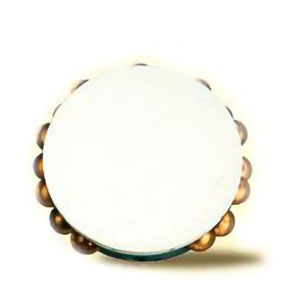The composition of the tambourine
It consists of drum frame, small cymbal and drum head. Drum frame, usually a wooden structure. Small cymbal, copper. Drum skin, mostly made of sheepskin.
The tambourine is available in three sizes: large, medium and small. The height of the drum frame is 4-4.7 cm, the thickness of the drum frame is 1.2-1.3 cm, and the diameter of the drum surface is 20-25 cm. The tambourine of the Tajik people has a unique shape. It is mostly made of old sieve frames, and is also covered with wolf skin or cowhide. There are 3 pairs of small cymbals in the frame, and the pronunciation is low and strong. When playing the tambourine, use the left hand to hold the drum and play it with the fingers or palm of the right hand. Shake the drum body to make the small cymbals sound at the same time. Mostly used for singing or dancing accompaniment, but also for instrumental ensemble.

Material used: drum frame: generally wooden structure. Small cymbal: copper. Drum skin: mostly made of sheepskin.
The characteristic of the musical instrument is a single-skinned sounding instrument, which can be sounded directly by percussion with no fixed pitch. Tambourine has the characteristics of simplicity and lightness, suitable for folk dance, and is widely used all over the world. When playing the drum body with one hand and the drum face with the other hand, drum and cymbal sounds (even bells) can be produced at the same time, which is often used to set off a warm atmosphere and express a happy mood. The sound is crisp and bright, and it can also emit a rapid and beautiful tremolo, which can really be described as "singing and dancing".
 渝公网安备 50010702504639号
渝公网安备 50010702504639号